And what better way to celebrate Thanksgiving
than with a Lucio Fulci gore film?
Incidentally, do not ask my family this.
My lack of respect for the Italian horror films
of the 70s-80s is nearly legendary; Marc Beschler and I have
had many a discussion over this. Now, I find Argento's movies
hard to watch for all the right reasons (his murder scenes make
me genuinely uncomfortable in a way that no other director has
ever managed); past that, the gialli movies seem to me
mere empty exercises in style (Fulci himself once termed the
genre "mechanical"), and conventional horror films
not much better. You see, I want stories, with identifiable
beginnings, middles and ends. So many Italian horror films seem
like a series of barely (if at all) connected shock scenes with
only the slightest nod toward a story to bring them together.
I find that sort of thing insulting in an American movie - moving
the film's source to Europe does not improve the flavor.
Fulci seems to provide the exceptions that prove
my rule, although The
Gates of Hell and The Beyond seem to exemplify
the "loosely connected shock scenes" complaint; the
difference is, these two movies shouldn't make sense.
They are about the Crawling Chaos, about Hell come to Earth
- and one expects reality to break down under those circumstances.
Other Fulci films, with theoretically more traditional
story structures, we will likely deal with at some other time
- just don't hold your breath until then, 'kay?
The movie begins in "Louisiana, 1927" or so the
subtitles inform us. Another clue is the fact that everything
is presented to us in sepia tone, which inevitably leads us
to fantasize what The Wizard of Oz would have been like
if the prologue had been set in Louisiana rather than Kansas.
Like a brightly colored Gator Bait with musical numbers,
I bet.
Oh, and lynch mobs. Lynch mobs converging on the
Seven Doors Hotel via rowboats and vintage cars. These grim-faced
men charge up the stairs to room 36 (just so there can be no
doubt as to the room number, I note that the management has
conveniently placed the numbers on both sides of the door).
Inside the room, the mob confronts an artist (Antoine Saint-John)
who is working on a singularly drab painting of a gray landscape
(well, brown, but it will turn gray later). The Mob Lead denounces
the painter as "an ungodly warlock" (as opposed to a Christian
warlock) and begins beating him with a chain. Although the wounds
slashed in his flesh are rendered in sepia, causing the flowing
blood to have the appearance of muddy water, there are still
long, loving Fulci zoom-ins to the carnage.
The mob then takes the painter to the basement,
where they give him the royal treatment: nail him to a wall,
throw bubbling quicklime on him and then wall up the dissolving
body, like a Cajun Cask of Amontillado. The Mob goes
through a lot of extra trouble for ungodly warlocks, eschewing
the more traditional burning at the stake or, 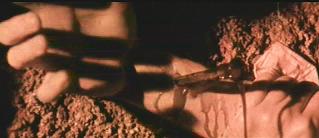 given
the fact that their crucifixion is historically accurate (nails
in the wrists, not through the palms), that they would have
taken a note from Salem, Mass and hanged him. (Although in the
Fulci cosmology, witches were burned at Salem, too). Though
to make an (unfortunately) historically accurate observation
of my own, the Mob would likely have felt that "hanging is for
uppity coons, and too good for the likes of him." But this sequence
is already ugly and stupid enough without bringing racism into
it.
given
the fact that their crucifixion is historically accurate (nails
in the wrists, not through the palms), that they would have
taken a note from Salem, Mass and hanged him. (Although in the
Fulci cosmology, witches were burned at Salem, too). Though
to make an (unfortunately) historically accurate observation
of my own, the Mob would likely have felt that "hanging is for
uppity coons, and too good for the likes of him." But this sequence
is already ugly and stupid enough without bringing racism into
it.
So let us leave the Good Old Warlock-Killin' Days
behind and go to the far-flung future of 1981, when a young
woman named Liza (Catriona MacColl) inherits the hotel and is
in the process of cleaning it up for a grand re-opening. She
is having problems with this - not only with the slow, slightly
sinister mother-and-son tag team of Andrew and Martha (Gianpaolo
Saccarola and Veronica Lazar), who "came with the house",
but strange events like the room service bell for Room 36 that
keeps ringing - although 36 is locked and no one knows where
the key has gone. Then a painter falls off a scaffold and keeps
raving (in between bouts of spitting up blood) about "The
eyes! The eyes!"
The injured painter brings into our story Dr.
John McCabe (David Warbeck). One of the better aspects of watching
Italian movies that take place in America is seeing the European
take on what life must be like in America (only fair, since
Hollywood has long been foisting off bizarre views of foreign
climes - I'd love to visit the Ireland portrayed in The Quiet
Man, and I'm sure many people in Ireland would, too). For
instance, doctors make house calls, and there are apparently
no ambulances, as McCabe has the others hustle the dying man
into his Lincoln. Yeah, let's move his spine around a little
more.
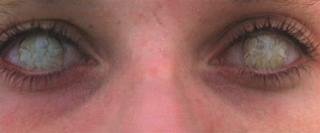 Speaking
of eyes (which we were a couple of paragraphs ago, as I recall)
Liza is driving into town across the world's longest causeway
when she nearly runs over a blind girl and her seeing-eye dog
standing in the middle of the road. This is Emily (Cinzia Monreale,
magically re-dubbed Sarah Fuller for the Amurrican audience),
whom, we suspect, was the owner of "The eyes! The eyes!",
since she's wearing a pair of the creepiest contact lenses I've
yet seen.
Speaking
of eyes (which we were a couple of paragraphs ago, as I recall)
Liza is driving into town across the world's longest causeway
when she nearly runs over a blind girl and her seeing-eye dog
standing in the middle of the road. This is Emily (Cinzia Monreale,
magically re-dubbed Sarah Fuller for the Amurrican audience),
whom, we suspect, was the owner of "The eyes! The eyes!",
since she's wearing a pair of the creepiest contact lenses I've
yet seen.
Emily is a font of knowledge about the hotel -
too bad she's not terribly forthcoming with her information.
Basically, she tells Liza that everyone who was at the hotel
sixty years ago disappeared without a trace, and that Liza should
simply leave and not look back. Later (after Liza does not simply
vamoose), she'll reveal that the painter at the beginning of
the movie was named Schweik, and he used the extremely evil
Book of Eibon to suss out that the Hotel was sitting on top
of one of the Seven Gates of Hell.
I've complained before that guardians of things
like Gates of Hell are overbearingly obscure in their duties,
speaking in riddles and mystifying commands to just leave, instead
of wrapping a banner around a cursed house that proclaims, WARNING:
CONTAINS ONE HELLMOUTH. DO NOT OPEN UNTIL DOOMSDAY. No, they
have to play it cute, until a bunch of people meet unfortunate
and violent fates, just like in The
Evil. In fact, The Beyond reminds me of The
Evil a lot... except I like The Beyond.
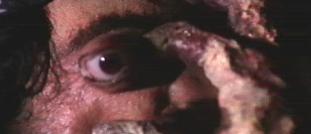 For
instance, there's Joe the Plumber (Giovanni de Nava), who arrives
to investigate the Hotel's mysteriously flooded basement*
and knocks down the mob's 1927 vintage wall to trace the leak.
This somehow has the effect of opening the Gate of Hell - Gates
of Hell are notoriously easy to open - and for his trouble,
Joe finds his face at the end of a zombie's outstretched hand,
and his eyeball sloooooooowly adorning his cheek. 'Cause it's
a Fulci film, y'know.
For
instance, there's Joe the Plumber (Giovanni de Nava), who arrives
to investigate the Hotel's mysteriously flooded basement*
and knocks down the mob's 1927 vintage wall to trace the leak.
This somehow has the effect of opening the Gate of Hell - Gates
of Hell are notoriously easy to open - and for his trouble,
Joe finds his face at the end of a zombie's outstretched hand,
and his eyeball sloooooooowly adorning his cheek. 'Cause it's
a Fulci film, y'know.
Weird Martha finds Joe's messy corpse, and as
a bonus, Schweik's body floats to the surface, and both wind
up in the hospital's morgue, where a young resident wants to
test out a theory by hooking up Schweik to his "brainwave
machine". Ahem, yes, let's hook up a sixty year-old corpse
to an EEG, that's a good idea. Where did you say you
went to medical school? (and were you also in charge of the
signs in the morgue? Like the one that reads, "Do Not Entry"?)
But hook him up he does, and of course the doc gets called away,
so he can't see his "brainwave machine" come to life.
Not that it would matter, as the machine is registering what
is patently a heartbeat. Maybe he hooked up the wrong
machine.
Joe's wife arrives to dress him for the funeral,
but sees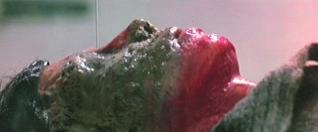 something off-camera and screams, causing her daughter, Jill
(Maria Pia Marsala) to rush in just in time to see her mother's
prone figure be the recipient of the contents of a tipped-over
five gallon jar of acid (any of you in the reading public who
work at either a hospital or morgue: please write and tell me
why a morgue would need a huge jug of acid. Thank you.)
Attempting to escape the widening pool of acid and Mom-goo,
Jill blunders through a door (following instructions, she does
not use the "Do Not Entry" door) and finds herself
face-to-face with more mangled cadavers. After this,
at the funeral of her parents, Jill evidences the heartbreak
of Emily Eyes.
something off-camera and screams, causing her daughter, Jill
(Maria Pia Marsala) to rush in just in time to see her mother's
prone figure be the recipient of the contents of a tipped-over
five gallon jar of acid (any of you in the reading public who
work at either a hospital or morgue: please write and tell me
why a morgue would need a huge jug of acid. Thank you.)
Attempting to escape the widening pool of acid and Mom-goo,
Jill blunders through a door (following instructions, she does
not use the "Do Not Entry" door) and finds herself
face-to-face with more mangled cadavers. After this,
at the funeral of her parents, Jill evidences the heartbreak
of Emily Eyes.
Just when you think you have Arthur and Martha
scoped out as Shills for Satan - after all Martha, doesn't flinch
when she finds Joe, and it is a sight that, discovered in a
darkened basement, would have sent anybody else running, screaming,
puking, or a combination of all three. But not our Martha, no,
she seemed somewhat unimpressed. But Arthur makes the mistake
of trying to brick up the Gate of Hell, and Martha encounters
the ambulatory Joe's corpse in Room 36, only to have her head
skewered on one of the crucifixion nails (now somehow transported
to the bathroom). And it is a Fulci film, so her eyeball
winds up dangling from the end of the nail.
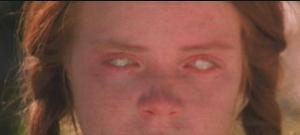 Liza's
friend, apparently some sort of contractor, goes to City Hall
and pulls out the original plans for the hotel, but finds something
there that causes him to gasp. Lightning flashes (as it does
at increasingly absurd times throughout the movie) and he falls
from the ladder, where spiders eat his face (and his eyeball,
goes without saying). Just as the worms in Gates of Hell
were unnervingly vocal, these spiders are far more noisy than
one would expect of lungless arthropods.
Liza's
friend, apparently some sort of contractor, goes to City Hall
and pulls out the original plans for the hotel, but finds something
there that causes him to gasp. Lightning flashes (as it does
at increasingly absurd times throughout the movie) and he falls
from the ladder, where spiders eat his face (and his eyeball,
goes without saying). Just as the worms in Gates of Hell
were unnervingly vocal, these spiders are far more noisy than
one would expect of lungless arthropods.
What did the contractor see? The movie doesn't
elaborate on it, but I think he saw a far larger underground
than was anticipated (or possible, given the locale). Unless
suspecting that will cause me to be startled by lightning in
an interior room and get my face slowly eaten by squeaky spiders.
In that case, forget I said anything.
In other movies, some characters seem to be around
to simply share their knowledge; Dr. McCabe's character seems
to be there to share what he doesn't know. For instance,
he's never heard of Arthur and Martha (let's see, New Orleans
has a population of around a half million... sure. He could
know everybody.). Nor has he heard of Emily, but he is
familiar with the house where Liza has frequently visited the
blind girl... and it's been deserted for fifty years!
 Emily
has other problems besides not existing, as Schweik and his
zombie goon squad come calling on her. She goes ballistic, informing
Schweik that she's "not going back!" and ordering
her seeing eye dog, Dickie, to attack the bad guy. Apparently,
coming desiccated face-to-snout to German Shepherd fury gives
Schweik pause, as he and his zombies disappear, leaving Emily
to embrace her canine savior. Who then tears her throat out.
Like the rain of maggots in Gates of Hell, this is a
moment cribbed from Argento's 1977 Suspiria. So what
exactly was Emily? A ghost? An escapee from Hell? Why was I
supposed to care?
Emily
has other problems besides not existing, as Schweik and his
zombie goon squad come calling on her. She goes ballistic, informing
Schweik that she's "not going back!" and ordering
her seeing eye dog, Dickie, to attack the bad guy. Apparently,
coming desiccated face-to-snout to German Shepherd fury gives
Schweik pause, as he and his zombies disappear, leaving Emily
to embrace her canine savior. Who then tears her throat out.
Like the rain of maggots in Gates of Hell, this is a
moment cribbed from Argento's 1977 Suspiria. So what
exactly was Emily? A ghost? An escapee from Hell? Why was I
supposed to care?
McCabe, meantime, plays Scully with the panicky
Liza, at least until he's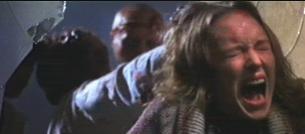 on the receiving end of some spookiness, and the two find themselves
trapped in the hospital with a bunch of zombies, since the Book
of Eibon (and The Gates of Hell, for that matter) helpfully
points out that when the Gates of Hell are open, the dead will
walk the earth. Luckily for our heroes, not only do the dead
walk at the speed of Tim Conway doing his doddering old man
routine (a half-inch is considered a long stride for these revenants),
but the head of the hospital keeps a loaded pistol and plenty
of ammo in his desk drawer.
on the receiving end of some spookiness, and the two find themselves
trapped in the hospital with a bunch of zombies, since the Book
of Eibon (and The Gates of Hell, for that matter) helpfully
points out that when the Gates of Hell are open, the dead will
walk the earth. Luckily for our heroes, not only do the dead
walk at the speed of Tim Conway doing his doddering old man
routine (a half-inch is considered a long stride for these revenants),
but the head of the hospital keeps a loaded pistol and plenty
of ammo in his desk drawer.
Now must we pause for a moment and consider the
Zombie Movie Law of Threes: when shooting a zombie, there must
be three shots; the first two are to the torso, and cause no
damage. The third is to the head, and puts the zombie down.
McCabe performs this ritual twice, which is fair enough, I suppose.
I mean, it's the scientific method - first, you make sure that
you can replicate the results of the original experiment. Unfortunately,
McCabe is using a revolver, which means that he has to reload
after putting down only two of a hallfull of zombies. Liza gets
away in the elevator to the morgue, and McCabe winds up sharing
a room with Mr. Brainwave Machine, who was hiding out while
the zombies killed everyone else.
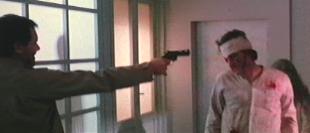 When
the zombies burst into the room, we think that McCabe has learned
his lesson: bang, bang, bang, bang. Head shot, head shot, head
shot, head shot. But after Dr. Brainwave winds up on the wrong
end of a shattering window (once
again, I had no idea that facial lacerations were fatal)
and Liza comes back for McCabe, and they wind up facing off
against Schweik in the morgue, all experience goes out the window
and McCabe wastes round after round into Schweik's chest. Maybe
McCabe went to the same university as Dr. Brainwave and the
sign guy.
When
the zombies burst into the room, we think that McCabe has learned
his lesson: bang, bang, bang, bang. Head shot, head shot, head
shot, head shot. But after Dr. Brainwave winds up on the wrong
end of a shattering window (once
again, I had no idea that facial lacerations were fatal)
and Liza comes back for McCabe, and they wind up facing off
against Schweik in the morgue, all experience goes out the window
and McCabe wastes round after round into Schweik's chest. Maybe
McCabe went to the same university as Dr. Brainwave and the
sign guy.
Oh, and Liza has been leading Jill around, too.
Remember Jill? The girl with the Emily Eyes? Well Jill goes
evil pretty darn fast and goes for Liza's eyes (As in Gates,
I notice that all Fulci zombies have the same attack) , but
McCabe pauses in his endeavor to fill up Schweik's torso with
lead long enough to blow Jill's head off. I am not employing
hyperbole here; whereas all the other critters shot in the head
evidence what looks suspiciously like a paintball hit, Jill's
head flies apart like a badly glued piñata.
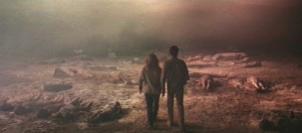 Liza
and McCabe try to escape to the hospital's basement, but instead
find themselves... back in the hotel's basement! Seeking a way
out, they walk through the Gate of Hell, and find themselves
in the bleak landscape of Schweik's painting, with no way back...
and they both have Emily Eyes. The end.
Liza
and McCabe try to escape to the hospital's basement, but instead
find themselves... back in the hotel's basement! Seeking a way
out, they walk through the Gate of Hell, and find themselves
in the bleak landscape of Schweik's painting, with no way back...
and they both have Emily Eyes. The end.
The ending, while infuriating initially, actually
makes artistic, if not dramatic sense, and is certainly better
than the hastily-improvised ending of Gates of Hell.
In fact, the best thing about The Beyond's re-release
by Quentin Tarantino's Rolling Thunder Pictures and Grindhouse
Releasing is this DVD widescreen rendering of the picture, with
Fulci's and cinematographer Sergio Salvati's artistic compositions
intact. It was previously unavailable in America except as Seven
Doors of Death, a truncated version with as much as twenty
minutes of footage missing, and the picture badly pan-and-scanned.
It was an incoherent mess. The Beyond is still
an incoherent mess, but at least is now an interesting and compelling
incoherent mess.
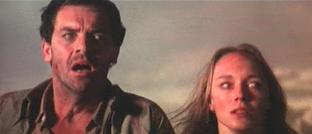 It's
the sort of thing that makes me look with suspicion at my copy
of Gates of Hell and that tape of House by the Cemetery
I rented years ago... had they been similarly mangled and compressed
beyond comprehension? Is the darkness of the final scenes in
Gates a bad video transfer, or could Fulci not afford
any lights that day? I don't know, and the quality of this pressing
is high enough to make me wonder.
It's
the sort of thing that makes me look with suspicion at my copy
of Gates of Hell and that tape of House by the Cemetery
I rented years ago... had they been similarly mangled and compressed
beyond comprehension? Is the darkness of the final scenes in
Gates a bad video transfer, or could Fulci not afford
any lights that day? I don't know, and the quality of this pressing
is high enough to make me wonder.
I also have to admit, it was refreshing to once
again see unapologetic, unashamed, 1980's full-tilt gore effects,
and The Beyond's effects are uniformly top-notch. If
Frederic Wertham had lived to see The Beyond or any of
Fulci's gore films, he would have crapped his pants. Beyond
contains three disem-eyeball-ments, a record even for Fulci,
for whom the damage-to the-eyeball things seems to be a continuing
motif; one that is either unsurprising or particularly disturbing
when one considers Fulci's background as an art critic. Still,
the eeriest moment in the movie has not a speck of gore: as
Liza and McCabe flee the deserted hotel, lights come on in the
rooms one by one, and the silhouettes of the people missing
for sixty years begin moving about in a building which was,
seconds ago, empty.
Overall, The Beyond is referenced by many
as the jewel in Fulci's crown, and I'm inclined to agree. If
you leave expectations of something like story behind,
it's a grand, nightmarish experience, surreal and often beautiful,
if you can get past the snap-zooms and so-so dubbing. Find the
DVD. If your video store has Seven Doors of Death, first
quake in awe and wonder, then thank them for keeping older,
out-of-print titles around. Then demand to know where they're
hiding the more current DVD.
And, oh yeah, it would probably help if you had
never seen Gates
of Hell or Suspiria, either.